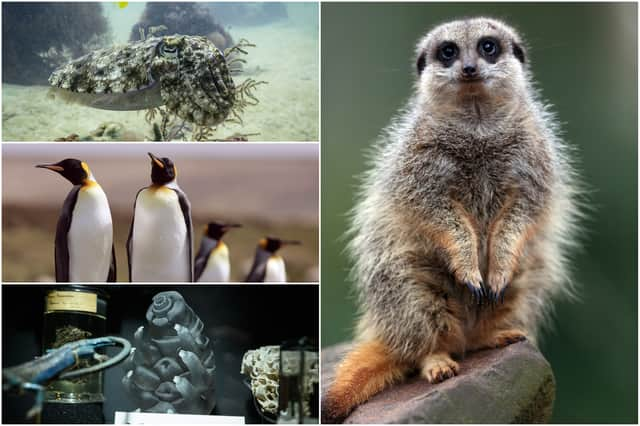16 of the best obscure animal facts: from swimming sloths to proposal pebbles - amazing facts


Ladies and gentlemen, brace yourselves for a zoological rollercoaster of wild wonders! Today, we're delving into the thrilling world of animal curiosities that'll make your eyebrows do the tango and your imagination pirouette.
Advertisement
Hide AdAdvertisement
Hide AdThese critters have tricks up their sleeves, or should I say, scales, fur or feathers. So, grab your safari hat, put on your nature detective monocle, and let's embark on a quirky quest through an enchanting land of 'Animazing' facts!
Sloths Can Swim
Despite their slow-moving reputation, sloths are surprisingly good swimmers. They use their long arms to paddle efficiently, and they can hold their breath for up to 40 minutes. So, if you ever find a sloth in need, it might just be a skilled swimmer!
Elephants Are Excellent Swimmers Too
Elephants are known for their size and strength, but did you know they're also fantastic swimmers? They use their trunk as a snorkel and can effortlessly glide through the water, covering great distances. Elephants truly are the gentle giants of both land and water.
Cows Have Best Friends
Cows are social animals and form strong bonds with others in their herd. Researchers have discovered that cows have best friends and can become stressed when separated from them.
Advertisement
Hide AdAdvertisement
Hide AdJust like humans, these bovine buddies prefer to spend their time with those they love.
Penguins Propose with Pebbles
Adélie penguins express their love through the gift of pebbles. Male penguins search for the smoothest, most appealing pebbles to present to their potential mates.
If the female accepts the pebble, they've just sealed the deal on their penguin partnership, and a beautiful courtship begins.
Butterflies Taste with Their Feet
Butterflies might seem delicate, but they're equipped with an interesting sensory feature. They "taste" with their feet!
Advertisement
Hide AdAdvertisement
Hide AdChemical receptors on their feet help them determine whether a plant is a suitable place for laying eggs. It's a unique way these colourful insects navigate their surroundings.
Ants Have Two Stomachs
Ants may be tiny, but they are efficient creatures. They have two stomachs - one for their own food and another called a "social stomach" to store food for other ants.
This communal dining system helps ensure the survival of the entire colony, emphasising their teamwork.
Hippopotamuses Produce "Blood Sweat"
Hippos secrete a reddish fluid often referred to as "blood sweat," although it's neither blood nor sweat.
Advertisement
Hide AdAdvertisement
Hide AdThis secretion acts as a natural sunscreen, protecting their sensitive skin from the harsh African sun and also has antimicrobial properties, keeping the hippos healthy in their watery environments.
Snails Have Thousands of Teeth
Snails might seem slow and gentle, but they possess a remarkable set of teeth. A typical snail can have thousands of microscopic teeth arranged in rows on their tongue, known as a radula.
This unique dental arrangement helps them scrape and break down their food efficiently.
Tardigrades Can Survive Extreme Conditions
Tardigrades, or water bears, are microscopic animals capable of surviving extreme conditions. They can endure intense heat, freezing temperatures, radiation, and even the vacuum of space.
Advertisement
Hide AdAdvertisement
Hide AdThis incredible resilience has earned them the reputation of being the toughest creatures on Earth.
Meerkats Assign Babysitting Duties
Meerkat communities have a unique social structure. Adult meerkats take turns serving as babysitters for the group's young.
This cooperative babysitting helps ensure the safety and well-being of the pups while allowing other members to forage for food. Teamwork is essential in the world of meerkats.
Cuttlefish Have W-shaped Pupils
Cuttlefish, relatives of squids and octopuses, have remarkable W-shaped pupils.
Advertisement
Hide AdAdvertisement
Hide AdThese pupils help them perceive polarised light, enhancing their ability to detect prey and communicate with other cuttlefish. The sophisticated vision of cuttlefish contributes to their success as agile and skilled hunters.
Star-Nosed Moles Are Speedy Eaters
The star-nosed mole has a bizarre-looking nose covered in 22 fleshy appendages, resembling a star.
This specialised nose is the fastest-known foraging organ in any mammal, allowing the mole to identify and consume prey in a fraction of a second. It's a super-quick and efficient dining strategy in the mole world.
Spiders Can Balloon Through the Air
Some spider species engage in "ballooning," a behaviour where they release silk threads into the air and use the wind to travel.
Advertisement
Hide AdAdvertisement
Hide AdThis aerial dispersal helps them explore new territories, find mates, and escape predators. It's a remarkable feat of tiny arachnid aviators.
Caterpillars Have More Muscles Than Humans
Despite their tiny size, caterpillars are muscular powerhouses. They have more muscles than humans – around 4,000!
These muscles, arranged in a coordinated manner, enable caterpillars to move with remarkable precision, showcasing the incredible biological diversity in the insect world.
Platypuses Are Biofluorescent
Platypuses, already known for their unique appearance, have another surprising trait – they are biofluorescent.
Advertisement
Hide AdAdvertisement
Hide AdUnder ultraviolet light, their fur, eyes, and even webbed feet emit a vibrant blue-green glow. The purpose of this biofluorescence in platypuses remains a fascinating mystery for researchers.
Ducks Have Multiple Eyelids
Ducks possess three eyelids – one for normal vision, one for keeping the eyes moist, and a third, transparent one that acts like goggles underwater.
This intricate eye structure enables ducks to see clearly both in the air and beneath the water's surface, enhancing their hunting and survival skills.
Comment Guidelines
National World encourages reader discussion on our stories. User feedback, insights and back-and-forth exchanges add a rich layer of context to reporting. Please review our Community Guidelines before commenting.
